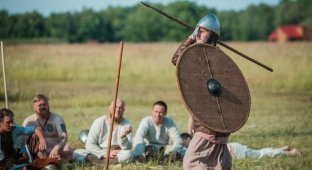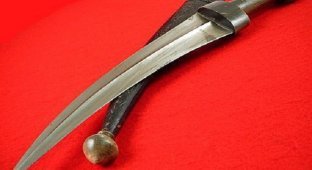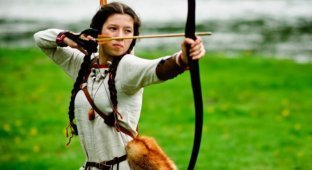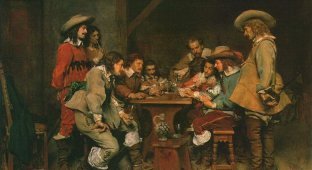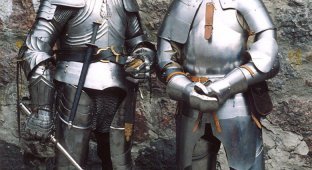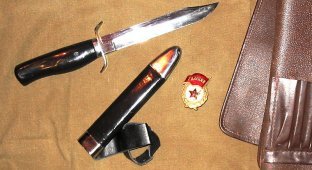I present to you a small selection of armor and weapons. I warn the lazy people at once there are not just a lot of letters, but a lot. For aesthetes, I want to add - it has not been read or verified. So you are not welcome here.
Russian voivode in a classic Russian helmet, under a real Russian banner.

A helmet is the most important and responsible element of protective equipment, because it is designed to protect the most valuable and vulnerable part of the human body. As a matter of principle, only the bravest heroes do not wear helmets, because a hero’s head is not the most important thing. Most often, the hero does not use it, otherwise he would not find himself in situations requiring the accomplishment of feats.
But the issue of head protection became really important at the moment when the warriors replaced spears with clubs. Even a light blow from a club to the temple can have fatal consequences for a person. And the first of the helmets were leather, semi-rigid helmets.

Semi-rigid helmets, a late example of which is the shako, were made of several layers of leather, withstood sword blows well and weighed about a kilogram. They were also known in ancient times: even in the Iliad, a leather helmet trimmed with boar tusks sawn lengthwise is mentioned as the heritage of their ancestors. Leather hats reinforced with bronze or iron plaques were used not only by nomads, where they certainly predominated. Similar equipment was also found among the Vikings and European knights. But in much smaller quantities. Warriors of antiquity and the Middle Ages gave unconditional preference to hard metal helmets. Even in the already mentioned Sumerian images, the warriors had copper helmets on their heads. However, leather was more accessible and cost less than any metal. And leather helmets continued to be used. Especially among the Germans, who defeated Rome. German soldiers used leather helmets, where the frame provided additional rigidity and protection. Made from whalebone, bone or horn. But the best material for such a frame, of course, was iron.

The frame was made like this: a strip of iron was bent and riveted into a ring, forming a hoop covering the head. Then several vertical teeth were welded to it. Alternatively, two more strips of iron could be bent in an arc and secured to the hoop crosswise. A leather cap was pulled over the resulting structure. Which simultaneously served as both protection and a sign of power. At the beginning of the era, only the leader could own such luxury. Only much later did leather give way to velvet, and roughly forged iron to skillfully crafted gold studded with stones. This is how we got the well-known symbol of power - the crown.

By the way, the famous cocked hats also had a similar frame. And even some hats. One of which, by the way, saved the life of the then Tsarevich Nikolai Alexandrovich. When a Japanese policeman dealt a chopping blow to the head of the future Emperor of Russia. During his visit to Japan. But either the katana turned out to be wooden, or we couldn’t penetrate the Zlatoust damask steel, but a similar frame, coupled with multi-layered fabric, saved Nikolai’s life then. But the blocking effect of the blow gave him lifelong migraines.



In general, leather helmets, for all their advantages, did not provide sufficient protection against crushing and chopping weapons (axes and clubs). Helmets made of soft materials, in the form of fabric turbans stuffed with hemp and hair, fur or felted hats, performed this task better, but turned out to be unnecessarily bulky. Yes, they justified themselves only as protection from sabers. When steel helmets were replaced in the army, first cocked hats came into use, and then shakos and leather helmets, including the famous bearskin hats of the English guards. Which, together with the frame, provided sufficient protection of the head from the cold, lighter weapons of the new time.

But still, unconditional preference was given to hard metal helmets. Which were cast first from copper, then from bronze. The form varied. The Sumerians and Assyrians liked simple, smooth caps. The Greeks preferred round, sometimes closed helmets with crests. Gauls are comfortable helmets with a "pike" similar to those worn by German infantry in the First World War. The helmets of the British and Irish tribes could be quite bizarre.



But peoples, willy-nilly, moved to iron metallurgy, which required much more complex skills to shape the strong but stubborn material. And to arm the countless armies of the empire, the Romans began to forge steel helmets. Reminiscent in shape to earlier bronze and iron ones. In the form of a not very deep bowl onto which various elements were riveted.

The Roman Empire ceased to exist in the 5th century. But another 2-3 centuries later, helmets made by Roman craftsmen still continued to be used in Europe. Gradually they lost the typically Romanesque cheek plates, backplates, and ridges. Rust and dashing blows of axes eventually did their job: the Roman helmets ended. And they were replaced by others. Created using a different, more primitive technology

The first all-metal Frankish, so-called segmental, helmets appeared in the 9th century, as a development of leather helmets. Sometimes they were round (the spaces between the intersecting arcs were riveted with four triangular segments). But much more common was a conical design, similar to the design of Russian, Byzantine and Middle Eastern helmets. But in any case they were composite. The long vertical teeth of the “crown” were welded end to end one another, bent inward, and fastened first with wire and a common horn base, and later by welding and riveting. The helmets had a fabric or leather lining and a chin strap. Sometimes helmets were additionally equipped with shock absorbers made of wool and rags. A mandatory element of the helmet was face protection. Because the blows to the face were frequent. In its simplest form, it could be an arrow - a nose, a mask - a domino, in the form of a half mask or a visor, sometimes in the form of a face. In the 9th-12th centuries, conical European helmets protected only the top of the warrior’s head, not even reaching the ears. In the east and in Rus', they were most often supplied with chain mail aventail. Europeans usually limited themselves to wearing only the helmet, since the helmet was always worn over a chainmail hood.





Russian helmets. With chain mail aventail.


Composite helmets were most developed in Japan. On the earliest type of this Japanese helmet, the main design element was a ridge running from front to back. Two stripes curved into rings were riveted to it - the upper one was at the level of the temples, and the lower one represented the crown of the helmet. The gaps between these three plates were filled with small rectangular (less often triangular) plates. Through holes in the crown, a neck protection made of 3-5 iron strips was attached to leather straps.

Later Japanese helmets were usually hemispherical in shape, with plates attached to protect the neck. The helmet was made of three or more riveted metal plates arranged from top to bottom; or made of leather, sometimes reinforced with metal plates. The neck protection elements consisted of a segmented backplate made of curved metal plates coated with varnish and connected by silk or leather straps.

The most unusual Japanese helmet was the kabuto. Lamellar helmet with a hemispherical crown, consisting of 8-12 segments, riveted together with 5-6 decorative rivets. A neck protection plate was riveted around the base of the crown. A small, almost vertical visor was riveted to the front. There were 2 or 4 holes made in the crown, covered with rivets, into which leather straps were attached, and a silk chin cord was attached to them. A bprmitsa consisting of 5 vertical rows, each of which consisted of 100-138 small plates, was attached to the plate to protect the neck. A cap sewn to the crown of the helmet was used as a balaclava.

By the 16th century, kabuto were divided into 2 types. The first, used by common soldiers, consisted of 6, 8, 12 or 16 plates; on officer helmets their number was 32, 64, 72 or 120, and such multi-plate helmets, due to unreliability, were most likely non-combat. Or were intended primarily for protection from arrows.

In Europe, already in the 10th century, another type of helmet appeared: round or egg-shaped cones, forged from a single iron sheet. The oldest known helmet of this type belonged to the Czech king Wenceslas I. The manufacture of a product of such a complex shape required a skill from the blacksmith that was unprecedented at that time. Such helmets became noticeably widespread only three centuries later. But in shape it remained the same conical helmet.
Helmet of King Wenceslas I.

In Rus' and in the eastern countries, a conical helmet, along the edges of which enemy blows easily slipped, remained practically the only option for a very long time. But he was constantly improving. Its dome was often entirely forged from damask steel or damascus, equipped with a high pommel with a tube for a plume, as well as additional plates covering the head from the sides, temple plates, and the back of the head. The nose arrow could be replaced by a folding half-visor covering the upper part of the face.

Damask Russian helmet (Cap of Jericho), 1621. Gunsmith Nikita Davydov, for Tsar Mikhail Romanov (copy of Alexander Nevsky’s helmet)
Damask steel, gold, precious stones, pearls, tauching, embossing, enamel, engraving.

During the 12th and 13th centuries, Europeans stopped forging conical helmets. The knights chose the original models. The first of these was a metal hat that appeared at the end of the 12th century, like a chapelle or capalin, similar to the British helmet of the early 20th century. The capalins were distinguished from the usual round four-sector helmet by the brim cut from a single iron sheet. The bet was made on the fact that chopping blows were delivered in a vertical plane or obliquely. The fields effectively protected the face from sword strikes and arrows falling at a high angle.

Later, the already simple manufacturing technology was simplified. The fields were made from an iron strip, heated and bent in a transverse plane. It was difficult to bring its edges together completely, and a triangular cutout usually remained on the side of the “hat” brim. Another stripe curved to form a crown. Then a slightly convex top was welded to it. In this form, already in the 14th century, the kapalin received wide recognition - both among foot and horse fighters, and became the most popular European helmet.

At the end of the 12th century, another original type of helmet appeared in Europe - a cylindrical helmet or tophelm, which was a “pan” or “bucket” with slots. Cylindrical helmets quickly became fashionable, since they were relatively easy to forge, and the structure itself was very durable. The line connecting the cylinder with the disk covering it on top formed a very rigid rib, upon impact with which an enemy sword could break. This helmet completely covered the face, which became another (and very significant!) advantage.

The shortcomings of the tophelm were also significant, due to which such helmets were not used anywhere except Western Europe (and there, as a rule, only in knightly tournaments). The most important thing is that the tophelm catastrophically limited the view. A horseman wearing such a helmet could fight only with spears and only until the ranks were mixed, and he could not fear an attack from the side. The uncontrollability of the knightly army, which has become the talk of the town, is largely due to the use of solid helmets. The knights in tophelms simply did not see the signs and did not hear the signals.
However, the “great helmets” served until the end of the 14th century and were constantly improved. So, at the end of the 13th century, the tophelm lengthened, and its edges began to rest against the shoulder plates of the shell. Combined with the comb, this provided an unprecedented level of head protection. Now the knight could not fear not only swords, but also axes.

In the 30s of the 14th century, the “great helmet” acquired a pointed top and something like a visor: a single or double door, by opening which one could find out whether there was a knight inside the tophelm and whether he was still alive. The question was quite appropriate, because there was not enough air in the thick helmet, and five minutes after the start of the battle the warrior began to suffocate. The knights were forced to often take off their helmets to catch their breath and look around. To prevent the tophelm from getting lost, it was equipped with a chain attached to the belt.
But even with a tophelm, the knight, for reasons already discussed, wore it only occasionally. This practice served to create a situation unprecedented in the history of weapons: in the 14th century, a second helmet, the bascinet, began to be worn under the large helmet.

Technology had advanced significantly by this time, and the bascinet was welded from two halves. The helmet had a streamlined round or pointed shape, and covered the head (except the face) completely. It is worth noting that when combining the “grand helmet”, bascinet and chainmail hood, the total weight of the head protection could reach 7 kilograms.
Already in the middle of the 14th century, the bascinet began to be worn without a tophelm, earning a reputation as comfortable and practical equipment. Acting as the only helmet, the bascinet was used in conjunction with a high steel collar covering the chin, or was equipped with a front face - a fixed visor, previously used in the design of Roman and Chinese helmets. At the same time, the foredress covered the lower part of the face.

Another type of helmet became common at this time - the barbute, or barbuda, which looked like an inverted bell. The shape and structure of the barbute (down to the T-shaped slot in the front part) were undoubtedly copied by Italian craftsmen from ancient images of the Corinthian helmet. The barbute completely covered the face, but at any moment it could turn into an open helmet - it could be moved to the back of the head.

By the beginning of the 15th century, the large tophelm and bascinet “merged”, forming a single model of a helmet, which inherited a streamlined shape from the bascinet, and from the tophelm the principle of resting on the shoulders. The front guards were replaced by a visor swinging on hinges.

Subsequently, the shape of the helmet became more complicated, forging technologies changed, but it was already the same “typical knightly” helmet, worn together with plate armor. In the most general case, it was now called “arme” (“weapons”). But the various designs, naturally, had their own names.

Particularly famous was the Hundsgugel (or “dog head”), whose visor had the grotesque appearance of a pointed cone. This shape served very practical purposes: the large surface area made it possible to make many holes for ventilation and made breathing easier, and the tip of an enemy spear could slide along the conical surface of the visor. At first, the “nose” of the Hundsgugels moved upward along the smooth and round surface of the helmets. Later, Arme acquired a much less noticeable visor.


But the most original helmet of the 15th century, of course, was the “frog head”. This helmet consisted almost entirely of a steel collar reaching to eye level. The collar was rigidly attached to the chest and back plates of the armor. The visor was the “lid” of this “pipe”. Throwing his head back, the knight could lift it with the back of his head and look around. But, having noticed some kind of threat, a person reflexively (and therefore instantly) bows his head. The lid slammed shut and even went behind the protruding “lower lip” - so that it was impossible to pick it up from the outside.

The “frog head” gave the owner absolute protection. But such helmets, which do not have openings in the “standard position” either for viewing or for breathing, were used almost exclusively in tournaments. In the 16th century, traditional knightly spear combat began to lose importance. This immediately affected full-face helmets: the requirements for visibility increased sharply. First, the visor was replaced by a large mesh grille, and the helmet itself “swelled up” - so that it was possible to turn your head in it. Then the closed helmets that rested on the shoulders disappeared completely.

In the 15th century, an alternative to the Hundsgugel was the saled (salada), a lightweight, streamlined helmet with small brims and a “tail.” The saled covered only the upper part of the face, and, like the barbute, it was easy to move it to the back of the head. This helmet was worn complete with a high steel collar reaching to the chin. When the warrior bent his head to his chest, the saled and collar closed, leaving no chance for the enemy. Saled did not impede breathing and did not prevent the warrior from turning his head. Very often, such a helmet was equipped with a folding visor. Becoming the crown of European-style helmets.


But all these helmets were difficult to manufacture and very expensive. without becoming the most popular European helmets.


They gave way in this to the Kabasset that appeared in the 15th century, which was replaced a little later by the Morion. As cheaper options for helmets. Available to most soldiers. They became a development of the “iron hat” concept.
Kabaset.





They were distinguished from the capalina by a high laterally flattened dome with an iron crest, as well as boat-curved fields. Kabaset is a helmet with a round high crown and small brim. Sometimes at the top of the crown there was a rod for attaching the sultan. The cabaset first appeared in France, where it was first used by mounted warriors, later becoming a common head of infantry, receiving the name “head pot”.

Morion is a helmet with a higher crest and brim that is strongly curved at the front and back. Appeared presumably in Spain at the beginning of the 16th century. Included in the armor set of foot spearmen. The pointed and upward-oriented visor contributed to the slipping of enemy blades when struck from the front. Both the cabaset and the morion were forged from one piece of metal.















